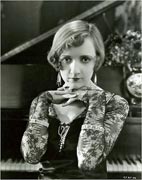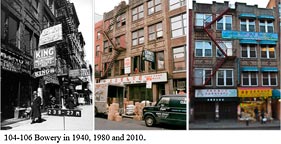A couple of worthy recent stories from The New York Times — one by Dave Kehr about the life and career of silent star Norma Talmadge:
An Independent Woman, Nobly Suffering in Silents
She was perhaps the biggest female star of the silent era. Her dark, depthless eyes gazed from the covers of influential fan magazines, projecting a nobly suppressed pain and longing; in the stories inside, she — or her ghost writers — advised the emerging independent American women of the 1920s on matters of fashion and home décor. She regularly topped the popularity polls, outdistancing rivals like Gloria Swanson, Pola Negri and Mary Pickford. She and her husband, the producer Joseph Schenck, founded their own production company in 1917; by 1924, The New York Times was identifying her as “the highest salaried screen actress.”
 Yet Norma Talmadge is barely remembered today. Worse, she is misremembered, having inspired two unfair caricatures that have lived on in a pair of popular films. In “Singin’ in the Rain” (1952), she is parodied as Lina Lamont (Jean Hagen), a silent diva whose Brooklyn accent undermines her talking debut in a French historical drama. (Talmadge’s second sound feature, the 1930 “DuBarry, Woman of Passion,” was indeed a failure, but Talmadge’s faint accent was the least of its problems.)
Yet Norma Talmadge is barely remembered today. Worse, she is misremembered, having inspired two unfair caricatures that have lived on in a pair of popular films. In “Singin’ in the Rain” (1952), she is parodied as Lina Lamont (Jean Hagen), a silent diva whose Brooklyn accent undermines her talking debut in a French historical drama. (Talmadge’s second sound feature, the 1930 “DuBarry, Woman of Passion,” was indeed a failure, but Talmadge’s faint accent was the least of its problems.)
More malignantly, Billy Wilder used Norma Talmadge as the obvious if unacknowledged source of Norma Desmond, the grotesque, predatory silent movie queen of his 1950 film “Sunset Boulevard.” Enthusiastically interpreted by Gloria Swanson, Talmadge’s rival in the 1920s, the Desmond character draws on Talmadge’s reclusiveness (she left films in 1930, living in a Beverly Hills mansion on the considerable fortune she had earned in her prime), her well-known affair with a younger man (the actor Gilbert Roland, her co-star in several ’20s hits) and her reputation for erratic behavior (suffering from severe arthritis, she became addicted to painkillers and in 1946 married her doctor) to compose the movies’ ultimate symbol of female sexual hysteria.
Norma Desmond has become ubiquitous in American popular culture, but Norma Talmadge has become all but invisible. Although an unusually high percentage of her films survive — “Of her 51 features, 32 are currently thought to be complete and 10 more are preserved in part,” Greta de Groat writes on her excellent Talmadge Web site (stanford.edu/~gdegroat/NT/home.htm) — until now only a handful of her earlier movies have been available on home video.
“The Norma Talmadge Collection” from Kino International corrects that lamentable situation by offering two Talmadge features from her glory years: the 1926 comedy “Kiki,” directed by Clarence Brown, and the 1923 melodrama “Within the Law,” directed by Frank Lloyd. Oddly, neither film is typical Talmadge. “Kiki” is a wholly anomalous comedy, with Talmadge as a Parisian street urchin who becomes a music hall star, and “Within the Law” strays from melodrama into crime-film territory. But there is enough here to get a sense of who Talmadge was and what her gifts were…. [read more]
And another, by Dan Barry, about a century and a half in the colorful life of a small hotel on the Bowery in New York City:
On the Bow’ry
Open the door to a small hotel on the Bowery.
A small hotel, catering to Asian tourists, that used to be a flophouse that used to be a restaurant. That used to be a raucous music hall owned by a Tammany lackey called Alderman Fleck, whose come-hither dancers were known for their capacious thirsts. That used to be a Yiddish theater, and an Italian theater, and a theater where the melodramatic travails of blind girls and orphans played out. That used to be a beer hall where a man killed another man for walking in public beside his wife. That used to be a liquor store, and a clothing store, and a hosiery store, whose advertisements suggested that the best way to avoid dangerous colds was “to have undergarments that are really and truly protectors.”
Climb the faintly familiar stairs, sidestepping ghosts, and pay $138 for a room, plus a $20 cash deposit to dissuade guests from pocketing the television remote. Walk down a hushed hall that appears to be free of any other lodger, and enter Room 207. The desk’s broken drawer is tucked behind the bed. Two pairs of plastic slippers face the yellow wall. A curled tube of toothpaste rests on the sink.
Was someone just here? Was it George? [read more]

